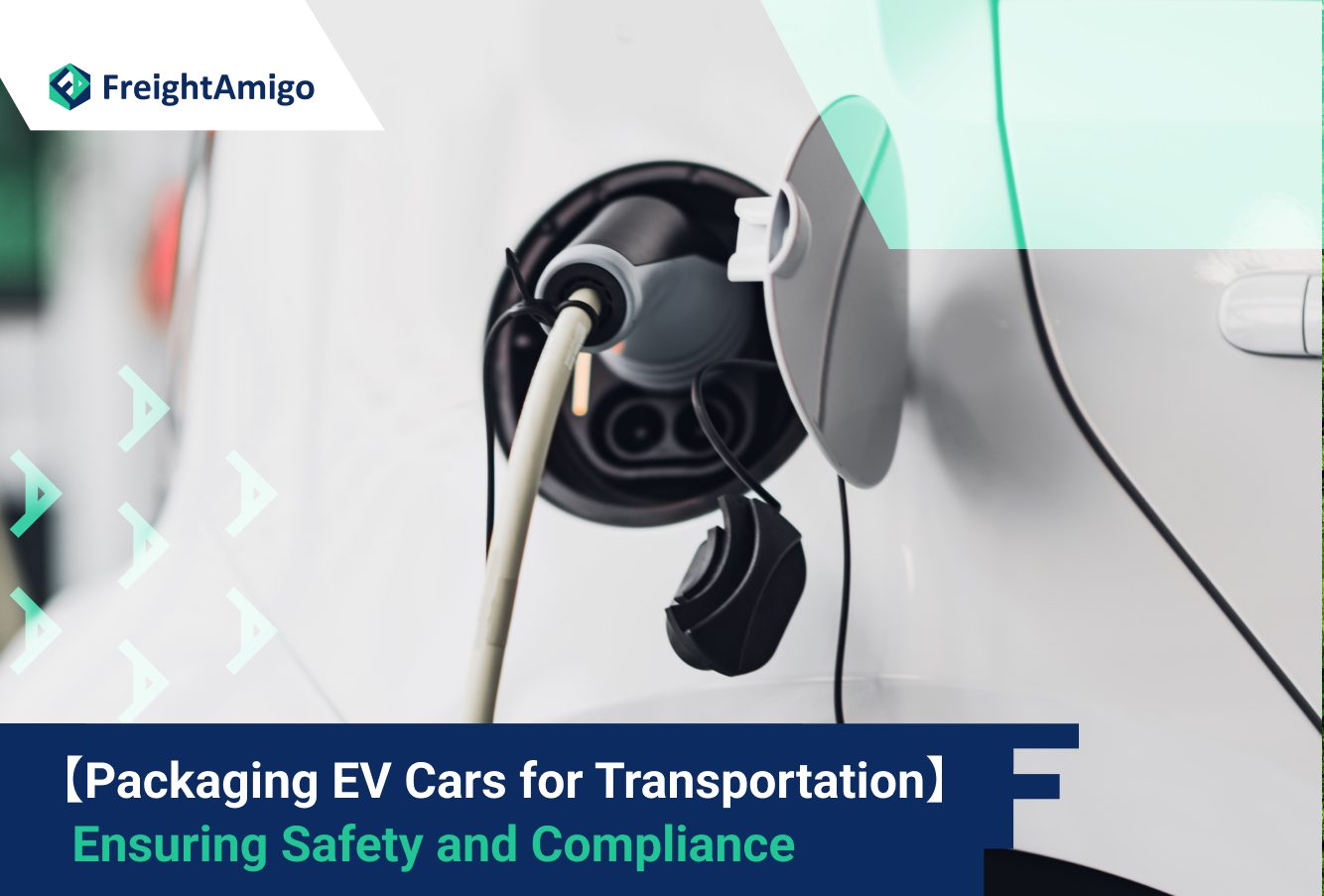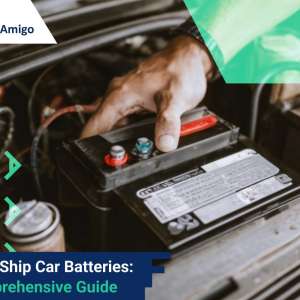Author Name: Aurora Park – Marketing Analyst at FreightAmigo
The electric vehicle (EV) industry has experienced remarkable growth over the past decade, attracting a younger, environmentally conscious generation with its cost-saving and energy-saving features. However, the transportation of EV batteries, which serve as the power source for these vehicles, presents unique challenges. In this article, we will explore the key considerations and best practices for packaging EV batteries for safe and compliant transportation.
Want to compare the best Express, Air Freight, Sea Freight, Rail Freight & Trucking rates so as to have better control on cost?
The Importance of Packaging Design
Shipping EV batteries requires adherence to strict regulations and guidelines due to their hazardous nature. Lithium-ion batteries, commonly used in EVs, are classified as dangerous goods by the Department of Transportation. Therefore, the packaging design must prioritize the protection of the batteries and ensure compliance with transportation regulations.
Inner Packaging
To prevent the batteries from coming into contact with each other, it is crucial to have a strong inner packaging design. Special attention should be given to preventing battery movement during transit, as any impact or vibration can potentially damage the batteries. The use of cushioning materials such as urethane foam provides effective vibration damping and impact resistance.
Outer Packaging
The outer packaging serves as an additional layer of protection and plays a critical role in complying with DOT requirements. Several design options are available to meet the specific needs of EV batteries:
- Plywood Boxes: These boxes, made from a combination of wood and steel, are both strong and lightweight, making them suitable for heavy EV batteries.
- Corrugated Board: Corrugated boxes lined with fitted Expanded Polypropylene foam are an excellent choice for preventing battery jostling during shipment. These boxes can be stacked and secured to pallets, saving space and reducing freight costs.
- Custom Packaging Materials: Depending on the battery size and other requirements, customized packaging solutions may be necessary. Collaborating with a packaging design firm experienced in meeting DOT regulations while providing cost-saving solutions is recommended.
Waste Management Hierarchy for EV Batteries
The European Union proposes a Waste Management Hierarchy as a guide to handling waste in the most environmentally desirable way. This hierarchy serves as a framework for effectively managing end-of-life EV batteries.
The Five Stages of Waste Management Hierarchy
The Waste Management Hierarchy consists of five stages, listed in order of preference:
- Prevention: The ideal approach is to prevent waste generation by promoting sustainable practices and reducing the use of non-renewable resources.
- Reuse: Extending the lifespan of products and components through refurbishment and reuse is another effective waste management strategy.
- Recycling: Recycling involves the recovery of valuable materials from waste, reducing the need for virgin resources and minimizing environmental impact.
- Recovery: When recycling is not feasible, energy recovery from waste can be an alternative, providing a source of renewable energy.
- Disposal: Disposal in landfill should be the last resort, as it has the highest environmental impact and contributes to resource depletion.
The Electric Vehicle Revolution: Driving Forces and Future Trends
The electric vehicle market is experiencing significant growth worldwide, with Europe leading the way in the adoption of EVs. This revolution is driven by various factors and is expected to shape the future of transportation.
Environmental Awareness
Increasing environmental awareness and the need to reduce greenhouse gas emissions have prompted governments and individuals to embrace electric vehicles. EVs offer a sustainable transportation solution, reducing reliance on fossil fuels and contributing to cleaner air quality.
Technological Advancements
Advancements in battery technology have significantly improved the performance and range of electric vehicles. As battery costs continue to decline, EVs are becoming more affordable and accessible to a broader consumer base.
Government Support and Regulations
Governments worldwide are introducing policies and incentives to encourage the adoption of electric vehicles. These measures include tax credits, subsidies, and the establishment of charging infrastructure, making EV ownership more attractive and convenient.
Transportation Electrification
The electrification of transportation extends beyond passenger cars. Commercial vehicles, public transportation, and even the aviation industry are gradually transitioning to electric power, further driving the demand for EVs.
Recycling Efficiency for Lithium-Ion Batteries
The European Union has set recycling efficiency as a metric to monitor recycling efforts and promote a circular economy. Recycling efficiency reflects the percentage of valuable materials recovered from end-of-life batteries.
Calculating Recycling Efficiency
Recycling efficiency is calculated by dividing the mass of recovered valuable materials by the mass of the entire battery. This metric helps evaluate the effectiveness of recycling processes and encourages the development of more efficient recycling technologies.
Responsibility of Manufacturers
Manufacturers play a crucial role in ensuring high recycling efficiency. They are responsible for designing batteries that are easily recyclable and implementing processes that facilitate the recovery of valuable materials. Collaboration between manufacturers, recyclers, and regulatory bodies is essential for improving recycling efficiency.
The Process of Lithium-Ion Battery Recycling
The recycling of lithium-ion batteries involves several steps to recover valuable materials and minimize environmental impact. Let’s explore the key stages of the recycling process.
Collection and Sorting
Used batteries are collected from various sources, including EV manufacturers, dedicated collection centers, and recycling facilities. Sorting is essential to separate different battery chemistries and identify suitable recycling pathways.
Battery Disassembly
In the disassembly stage, batteries are carefully dismantled to access the individual components. This process requires specialized equipment and skilled technicians to ensure the safe handling of potentially hazardous materials.
Material Recovery
After disassembly, the recovered battery components undergo further processing to extract valuable materials. These materials include metals such as lithium, cobalt, nickel, and copper, which can be reused in the production of new batteries or other applications.
Treatment of Hazardous Waste
During the recycling process, hazardous waste, such as electrolytes and certain chemicals, is treated according to regulatory requirements. Proper waste management ensures the safe handling and disposal of potentially harmful substances.
New Value Streams in the Automotive Industry
The shift towards electrification in the automotive industry brings new opportunities for value creation. Let’s explore some of the emerging value streams associated with the electric vehicle market.
Battery Second Life
Batteries that are no longer suitable for use in EVs can still serve other purposes. These retired batteries can be repurposed for energy storage applications, providing a valuable source of renewable energy storage and reducing the need for new battery production.
Battery Recycling and Raw Material Recovery
The recycling of EV batteries not only helps recover valuable materials but also reduces the reliance on mining for raw materials. Recycling facilities can extract metals from used batteries, ensuring a sustainable supply of critical resources for battery production.
Charging Infrastructure Development
The increasing adoption of electric vehicles necessitates the expansion of charging infrastructure. Companies involved in the development, installation, and maintenance of charging stations can capitalize on the growing demand for convenient and accessible charging solutions.
Software and Connectivity Solutions
Electric vehicles rely heavily on software and connectivity for efficient operation. Companies specializing in software development, data analytics, and connectivity solutions have the opportunity to provide innovative services that enhance the overall EV ownership experience.
Conclusion
Packaging EV batteries for transportation requires careful consideration of safety and compliance regulations. Inner and outer packaging designs must protect the batteries from damage while adhering to Department of Transportation guidelines. Additionally, the recycling of end-of-life EV batteries plays a crucial role in the sustainability of the electric vehicle industry. As the electric vehicle revolution continues to gain momentum, it is essential to prioritize responsible packaging and recycling practices to support the growth of this sustainable transportation solution.
There are different options for cargo transportation. If you want to choose the most convenient and suitable solution, it is best to have the full support of logistics experts! If you are planning to ship goods overseas, please go to the FreightAmigo page for inquiries.
===
Read More:
Revolutionizing The Automotive Supply Chain: An Insight Into Finished Vehicle Logistics
【Electric Trucks】Revolutionizing Sustainable Logistics
Driving Into The Future: How Self-Driving Technology Is Transforming Trucking And Transportation
===
If you have any inquiries on logistics/supply chain, feel free to contact FreightAmigo now:
Phone : +852 28121686
WhatsApp: +852 27467829









































